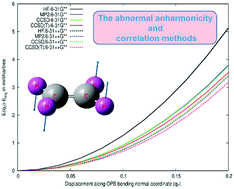Anomalous description of the anharmonicity of bending motions of carbon–carbon double bonded molecules with the MP2 method: ethylene as a case study†
Abstract
In this work, we report anomalous descriptions of bending modes of the smallest carbon–carbon double bonded molecule ethylene with the MP2 method. The harmonic frequencies of the out-of-plane modes are found to be extremely low and the anharmonicities are found to be very large. Although the problem of harmonic frequencies of these out-of-plane vibrations disappears with larger basis sets, the anharmonicity of these modes is still found to be extremely large. Such anomalous anharmonicity with the MP2 method is not limited to out-of-plane modes and smaller basis sets. The anharmonic frequency of in-plane vibration CH2 rocking with a large basis set 6-311G(3d,3p) is much higher than the experimental value. The errors are not restricted to the MP2 method, but propagate to highly accurate ab initio methods like CCSD and CCSD(T). We found that such anomalous behavior of the post-Hartree Fock method for the bending motions of ethylene originates from the erroneous descriptions of the virtual molecular orbitals, especially with diffused basis sets.

- This article is part of the themed collection: 2018 PCCP HOT Articles


 Please wait while we load your content...
Please wait while we load your content...